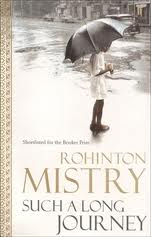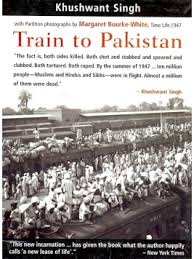I am tempted to summarize my thoughts about Rohinton Mistry’s Such a Long Journey with his own words – quite a bit of a journey, but that would both be highly unoriginal and oversimplified, if not completely untrue. There is much that I enjoyed about the book and little that I can honestly kick up a fuss about.
Such a Long Journey (1991) is set in the early 1970s and its characters are overwhelmingly and colorfully Parsi and middle-class. The protagonist, Gustad Noble, is a middle-aged bank employee whose life, if not quite beset by tragedy, has been singularly unsatisfactory. He works hard to achieve respectability despite struggling to manage the needs of his family (a wife and three kids) on his small income. Already embittered by his circumstances, Gustad’s frustrations are aggravated by his eldest son who refuses to join the prestigious IIT and instead elects to pursue a lowly arts degree; by what he perceives as betrayal by one of his closest friends; by his daughter’s persistent sickness which weighs heavily on the family’s finances; by the suffering of his ailing colleague and office clown; and a host of other everyday problems, including his building’s wall being used as an open toilet. There are many, many characters: colleagues, neighbors, friends, community members, some eccentric, some pitiable, and some mysterious. Although Mistry takes the time to develop Gustad’s character and explore his past, his weaknesses, his thoughts and actions, I felt that he could have delved more deeply into some other (non-minor) characters and their motivations.
Politics, both local and national, provide a backdrop of unrest and disquiet, and Mistry’s characters frequently criticize the Shiv Sena, and the policies of Indira Gandhi and her “car manufacturer” son, RAW (India’s intelligence agency), and deplore the (East-Pakistan) refugee situation and the resulting mandatory refugee tax. Mistry pretends prescience when a vengeful character declares a thinly veiled threat:
I may collect my payment tomorrow, or next year, or after ten years. From whoever is responsible. If it’s the car manufacturer, he will have to pay. Lots of possibilities – his car might explode, for instance. He also likes to fly aeroplanes, so: bhoom, crash, the end…Mummy herself has many enemies. Makes more and more every day, from Punjab to Tamil Nadu. Any one of them could do it.
The “car manufacturer” died in air crash in 1980, and “mummy”, of course, was assassinated by her bodyguards in 1984.
India’s unsuccessful war with China, and its ongoing war with Pakistan are also a frequent topic of office banter. Mistry seems to presume a fair amount of knowledge of the politics of the Indian subcontinent. For those unfamiliar with it, some homework is definitely called for.
Mistry excels at capturing the everyday difficulties of the common man, the dynamics between the various members of the Noble family, as well as their interaction with others, as does he shine at depicting the close-knit Parsi community and its practices. I enjoyed his description of the clinical setting and methods of traditional bonesetters; but had mixed feelings towards the “black magic” that is employed by Noble’s wife to try to manage their wayward son. While the concept, in an Indian context, is not quite alien to me, I was mildly disturbed by the use of nail clippings and lizard tails to ward off the evil eye.
But for me, the segment that provoked most thought was the debate around the traditional Parsi system of disposing off the dead – The Tower of Silence – a flat open air auditorium with three concentric circles, where dead men, women and children are left to be consumed by vultures, and their bones bleached by the sun. Parsis, traditionally, are averse to cremation, burial, or submergence because they consider fire, land and water to be sacred, and corpses to be unclean. However, the ancient ritual is often incongruous with glamorous luxury high rises. Vultures scattering titbits and body parts on million rupee balconies do nothing to endear the practice to city dwellers. Moreover, traditionally, scavenging birds consumed the body in a matter of hours. With the dwindling vulture population, this process is often protracted and bodies lie decomposing on the tower, and raising quite a stink. Aviaries to breed vultures, and solar reflectors to accelerate the decomposition notwithstanding, this subject continues to evoke a raging debate between the orthodox, or “vulturists” as Mistry calls them, and the reformists.
Gustad Noble’s is a long journey, from troubled to accepting, from bitter to considerate, and though a tad slow, I found Mistry’s drama to be engaging and rich in details.





